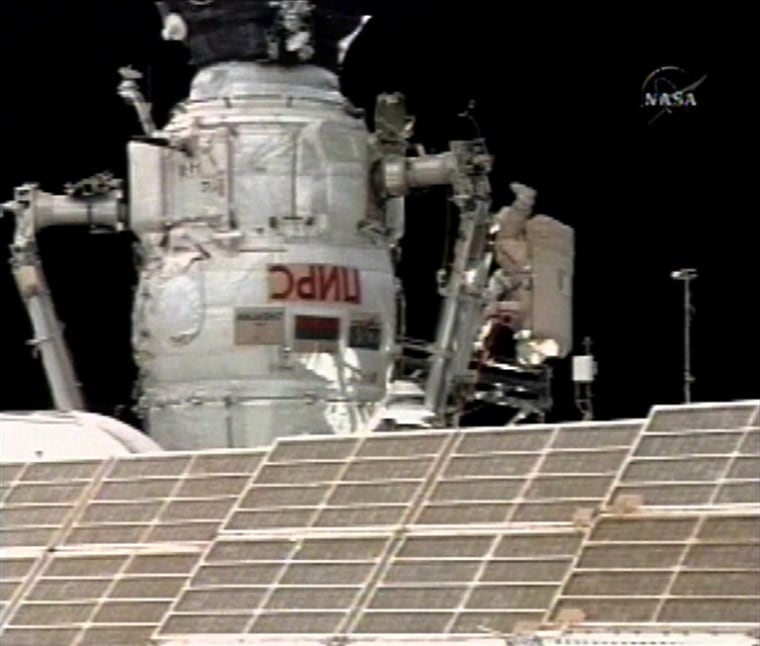A U.S. astronaut and his Russian crewmate took their tools and stepped outside the international space station for an orbital repair job Thursday, fighting an overheated spacesuit with a fogged-up helmet to fix a faulty antenna.
When a hammer didn’t do the trick, cosmonaut Mikhail Tyurin cut a metal lock holding the antenna in place with a tool resembling garden shears — breathing heavily in the heat of a suit plagued by temperature control problems through much of the 6-hour, 13-minute spacewalk.
Tyurin and American astronaut Michael Lopez-Alegria were dispatched to free up the stuck antenna on a Russian Progress cargo ship, to keep it from snagging when the vessel undocks from the station. The Progress must be jettisoned from the station before a Soyuz spacecraft can deliver a new crew in early April.
Not long after Tyurin and Lopez-Alegria left the station, Mission Control told the Russian that his suit’s temperature control system wasn’t working at full capacity — and that he would have go back inside if it got much worse.
“Please pay attention to your condition while you work. If you feel it’s too hot, then take a break,” Mission Control said.
Replied Tyurin: “One who knows something about life is never in a hurry.”
When they reached the offending antenna — crawling painstakingly from railing to railing over the station’s white surface — Mission Control told Tyurin to reach for his hammer.
“I’m not seeing it,” he said. “Because of this temperature problem, my glass has fogged all over.”
Not an easy job
Lopez-Alegria tried to free up the antenna with a few blows from a small hammer, but the lock did not give. The two quickly switched to the metal-cutting device, saying they wanted to save time.
Mission Control suggested Lopez-Alegria do the work because of Tyurin’s suit trouble, but the Russian said he was in a better position, with both hands free.
Slideshow 12 photos
Month in Space: January 2014
He set out to cut the lock that held the antenna in place, his breath coming fast and his helmet’s glass visor sometimes clouding with vapor.
At Mission Control’s suggestion, Tyurin wiped off his visor by rubbing his nose against the glass. The problem eased, he said, when he was not exerting himself.
“When I move a bit less, it dries up a little,” he said.
Tyurin was alternately philosophical and mildly impatient during lengthy exchanges with officials at Mission Control in Korolyov, northeast of Moscow. He suggested a few times that the work might be quicker without so many instructions.
“Are we going to cut or are we going to talk?” he said at one point.
Preparing for the spacewalk, the pair had watched a video of engineers on the ground cutting up an identical lock. But the task proved arduous.
When one of Tyurin’s cuts went awry, the pair struggled to bend a tube to free the antenna. But it didn’t budge sufficiently and a third cut was required instead of the expected two, to free the antenna so it could be folded.
Alexander Polishchuk of Mission Control said that the temperature in Tyurin’s suit rose by as much as 3½ degrees above the desired range of 64.4 to 68 degrees Fahrenheit.
Necessary for undocking
Nikolai Sevastianov, the chief of Russian spacecraft manufacturer Energia, said the antenna had to be folded to prevent it from destabilizing the Progress M-58 cargo ship when it undocks. “We needed to fold this antenna so it doesn’t obstruct the undocking,” said.
When the Progress docked with the station in October, the antenna got stuck in a railing. The crew was unable to free the antenna during a previous spacewalk.
Their main job done, Lopez-Alegria and Tyurin moved on to other tasks, including collecting scientific experiments outside the spacecraft.
Had they failed to fold the antenna, they would have had to cut it off, Mission Control spokesman Valery Lyndin told The Associated Press.
During the more routine work, Tyurin’s suit-temperature problem dissipated — apparently of its own accord — and his mood lightened.
At one point, the Russian paused to marvel at the sight of a brightly lit city below. Lopez-Alegria, speaking Russian, later admired the way the sun glanced off the station’s solar panels.
After the hatch was closed and they rejoined American crew member Sunita Williams, Mission Control’s Polishchuk praised them.
“They had a strong desire to finish the work and they worked in the shade when they were supposed to rest,” he said. “It helped us to do the job in full.”
The spacewalk was the 10th for Lopez-Alegria, who set a U.S. record for total time walking in space — 61 hours and 22 minutes — when he and Williams did maintenance work outside the space station earlier this month. Russian cosmonaut Anatoly Solovyov holds the world record with more than 82 hours.
Progress ships regularly ferry supplies to the international space station. Shortly before a new cargo ship is launched, the old one — filled with garbage — is removed and dumped in the ocean to free the docking port.

